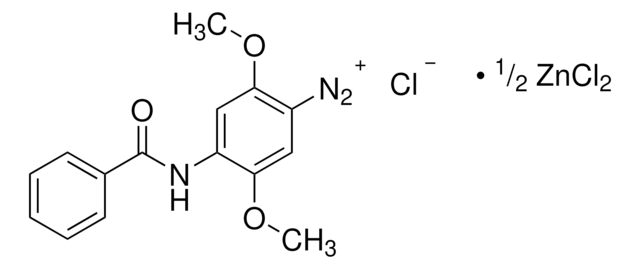202487
Poly(ethylene glycol) methyl ether
average MN 550, methoxy, hydroxyl
Sinonimo/i:
Polyethylene glycol monomethyl ether
About This Item
Prodotti consigliati
product name
Poly(ethylene glycol) methyl ether, average Mn 550
Densità del vapore
>1 (vs air)
Tensione di vapore
0.05 mmHg ( 20 °C)
Forma fisica
semisolid
PM
average Mn 550
Indice di rifrazione
n20/D 1.455
Viscosità
7.5 cSt(210 °F)(lit.)
Temp. transizione
Tm 20 °C
Densità
1.089 g/mL at 25 °C
Estremità Ω
hydroxyl
Estremità α
methoxy
InChI
1S/C3H8O2/c1-5-3-2-4/h4H,2-3H2,1H3
XNWFRZJHXBZDAG-UHFFFAOYSA-N
Cerchi prodotti simili? Visita Guida al confronto tra prodotti
Applicazioni
Poly(ethylene glycol) methyl ether-grafted polyamidoamine (PAMAM) dendrimers can be used as drug carrier systems for anticancer drugs.
Codice della classe di stoccaggio
10 - Combustible liquids
Classe di pericolosità dell'acqua (WGK)
WGK 1
Punto d’infiammabilità (°F)
359.6 °F - closed cup
Punto d’infiammabilità (°C)
182 °C - closed cup
Certificati d'analisi (COA)
Cerca il Certificati d'analisi (COA) digitando il numero di lotto/batch corrispondente. I numeri di lotto o di batch sono stampati sull'etichetta dei prodotti dopo la parola ‘Lotto’ o ‘Batch’.
Possiedi già questo prodotto?
I documenti relativi ai prodotti acquistati recentemente sono disponibili nell’Archivio dei documenti.
I clienti hanno visto anche
Articoli
Biofouling control essential for device performance and safety; minimize accumulation of biomolecules and bioorganisms.
Progress in biotechnology fields such as tissue engineering and drug delivery is accompanied by an increasing demand for diverse functional biomaterials. One class of biomaterials that has been the subject of intense research interest is hydrogels, because they closely mimic the natural environment of cells, both chemically and physically and therefore can be used as support to grow cells. This article specifically discusses poly(ethylene glycol) (PEG) hydrogels, which are good for biological applications because they do not generally elicit an immune response. PEGs offer a readily available, easy to modify polymer for widespread use in hydrogel fabrication, including 2D and 3D scaffold for tissue culture. The degradable linkages also enable a variety of applications for release of therapeutic agents.
Designing biomaterial scaffolds mimicking complex living tissue structures is crucial for tissue engineering and regenerative medicine advancements.
Il team dei nostri ricercatori vanta grande esperienza in tutte le aree della ricerca quali Life Science, scienza dei materiali, sintesi chimica, cromatografia, discipline analitiche, ecc..
Contatta l'Assistenza Tecnica.




